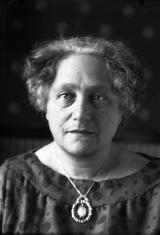Who married Albert Einstein?
Mileva Marić married Albert Einstein in . The age gap was 3 years, 2 months and 23 days.
The marriage ended in . Cause: divorce
Elsa Einstein married Albert Einstein on . Albert Einstein was 40 years old on the wedding day (40 years, 2 months and 29 days). Elsa Einstein was 43 years old on the wedding day (43 years, 4 months and 25 days). The age gap was 3 years, 1 months and 24 days.
The marriage lasted 17 years, 6 months and 8 days (6401 days ). The marriage ended on .
Albert Einstein

Albert Einstein (14 March 1879 – 18 April 1955) was a German-born theoretical physicist who is best known for developing the theory of relativity. Einstein also made important contributions to quantum mechanics. His mass–energy equivalence formula E = mc2, which arises from special relativity, has been called "the world's most famous equation". He received the 1921 Nobel Prize in Physics for his services to theoretical physics, and especially for his discovery of the law of the photoelectric effect
.
Born in the German Empire, Einstein moved to Switzerland in 1895, forsaking his German citizenship (as a subject of the Kingdom of Württemberg) the following year. In 1897, at the age of seventeen, he enrolled in the mathematics and physics teaching diploma program at the Swiss federal polytechnic school in Zurich, graduating in 1900. He acquired Swiss citizenship a year later, which he kept for the rest of his life, and afterwards secured a permanent position at the Swiss Patent Office in Bern. In 1905, he submitted a successful PhD dissertation to the University of Zurich. In 1914, he moved to Berlin to join the Prussian Academy of Sciences and the Humboldt University of Berlin, becoming director of the Kaiser Wilhelm Institute for Physics in 1917; he also became a German citizen again, this time as a subject of the Kingdom of Prussia. In 1933, while Einstein was visiting the United States, Adolf Hitler came to power in Germany. Horrified by the Nazi persecution of his fellow Jews, he decided to remain in the US, and was granted American citizenship in 1940. On the eve of World War II, he endorsed a letter to President Franklin D. Roosevelt alerting him to the potential German nuclear weapons program and recommending that the US begin similar research.
In 1905, sometimes described as his annus mirabilis (miracle year), he published four groundbreaking papers. In them, he outlined a theory of the photoelectric effect, explained Brownian motion, introduced his special theory of relativity, and demonstrated that if the special theory is correct, mass and energy are equivalent to each other. In 1915, he proposed a general theory of relativity that extended his system of mechanics to incorporate gravitation. A cosmological paper that he published the following year laid out the implications of general relativity for the modeling of the structure and evolution of the universe as a whole. In 1917, Einstein wrote a paper which introduced the concepts of spontaneous emission and stimulated emission, the latter of which is the core mechanism behind the laser and maser, and which contained a trove of information that would be beneficial to developments in physics later on, such as quantum electrodynamics and quantum optics.
In the middle part of his career, Einstein made important contributions to statistical mechanics and quantum theory. Especially notable was his work on the quantum physics of radiation, in which light consists of particles, subsequently called photons. With physicist Satyendra Nath Bose, he laid the groundwork for Bose–Einstein statistics. For much of the last phase of his academic life, Einstein worked on two endeavors that ultimately proved unsuccessful. First, he advocated against quantum theory's introduction of fundamental randomness into science's picture of the world, objecting that God does not play dice
. Second, he attempted to devise a unified field theory by generalizing his geometric theory of gravitation to include electromagnetism. As a result, he became increasingly isolated from mainstream modern physics.

Mileva Marić

Mileva Marić (Serbian Cyrillic: Милева Марић, pronounced [milěːva mǎːritɕ]; 19 December 1875 – 4 August 1948), sometimes called Mileva Marić-Einstein (Милева Марић-Ајнштајн, Mileva Marić-Ajnštajn), was a Serbian physicist and mathematician. She showed intellectual aptitude from a young age and studied at Zürich Polytechnic in a highly male dominated field, after having studied medicine for one semester at Zürich University. Her studies included differential and integral calculus, descriptive and projective geometry, mechanics, theoretical physics, applied physics, experimental physics, and astronomy. One of her study colleagues at university was her future husband Albert Einstein, to whose early work Marić is thought by some to have contributed (in particular the annus mirabilis papers).
Read more...Wedding Location
Albert Einstein


Elsa Einstein
